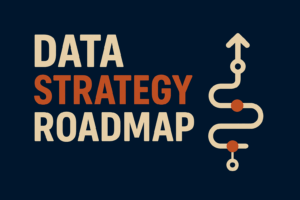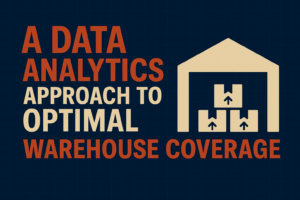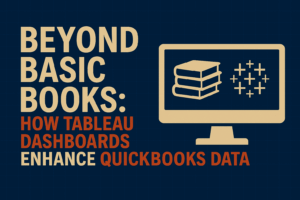As a part of the data strategy process a data roadmap is created to document the prioritization of projects.
Read MoreData Strategy
“Give me six hours to chop down a tree and I will spend the first four sharpening the axe” – Abe Lincoln
Abe Lincoln’s quote speaks about proper preparation over hasty action leading to the desired outcome. This holds true in data analytics. Having a strategy is paramount to creating a data driven organization. A New Vantage Partners survey reported that while 99% of firms invested in data initiatives, only 24% of firms said they created a data driven organization. A lack of data strategy is a major contributor to such poor return on investment.
Some common side effects of a lack of a data strategy are:
- Intuition only decision making
- Investment in new technologies or projects but a lack of direction on what is next
- Low adoption of analytics and reports
- Mistrust due to poorly defined data
- Time consuming manual ingestion and reporting of data
If these problems seem familiar this article will get you on the right track by answering the following questions:
- What is a data strategy?
- Who uses a data strategy? How is data strategy used?
- What are the building blocks of a data strategy?
What is a Data Strategy?
A data strategy is a long-term plan that defines the people, processes, and technologies necessary to use data to support your business goals. A data strategy gives you actionable steps to reach the desired end state. A strategy should be customized to your business goals and challenges. A well-crafted strategy considers your business’ capabilities, maturity, and industry to create a practical data analytics plan to drive business value.
Who uses a data strategy? how is data strategy used?
Data strategy is defined in a document which serves as an organization’s North Star. This document contains the plan, schedule, and outcomes for the data strategy. This document is shared across the organization to provide clarity, increase buy-in, and communicate the business value being driven by the data team.
what are the building blocks of data strategy?
Alignment to business goals
Aligning your data strategy to your business goals is the most important aspect of data strategy. Alignment increases business buy in, allows you to demonstrate clear value, and makes the case for prioritization of data projects.
To achieve alignment, you should follow these steps
- Complete interviews with executives to determine the business goals and the biggest challenges they encounter to meet those goals. Some examples of questions are below.
- What specific business goals do you have for the next year and next 5 years?
- What hurdles are preventing you from achieving those goals?
- How can solving those hurdles get you closer to your goals?
- What cost does not solving the hurdle carry?
- Conduct interviews with key stakeholders that impact the findings from the executive interviews. Some example questions are below.
- What information is lacking that prevents day-to-day operations?
- How could this information impact their actions?
- Dig into the interviews to identify relevant business levers that can be improved using analytics.
These steps should allow you to create a list of projects aligned to your business goals. This list will be helpful when building your data strategy roadmap.
Data analytics maturity hierarchy
The data analytics hierarchy measures your organization’s data maturity level. You need to know where you are at to create a realistic plan with incremental steps to achieve your goals. The graphic below displays the hierarchy and distinctions about each state. It is important to note that the hierarchy is a sliding scale. Your business may be spread across multiple states. Your position is the average state on the hierarchy. Your projects should assess what current and future maturity level the project is solving. This will help you prioritize projects.
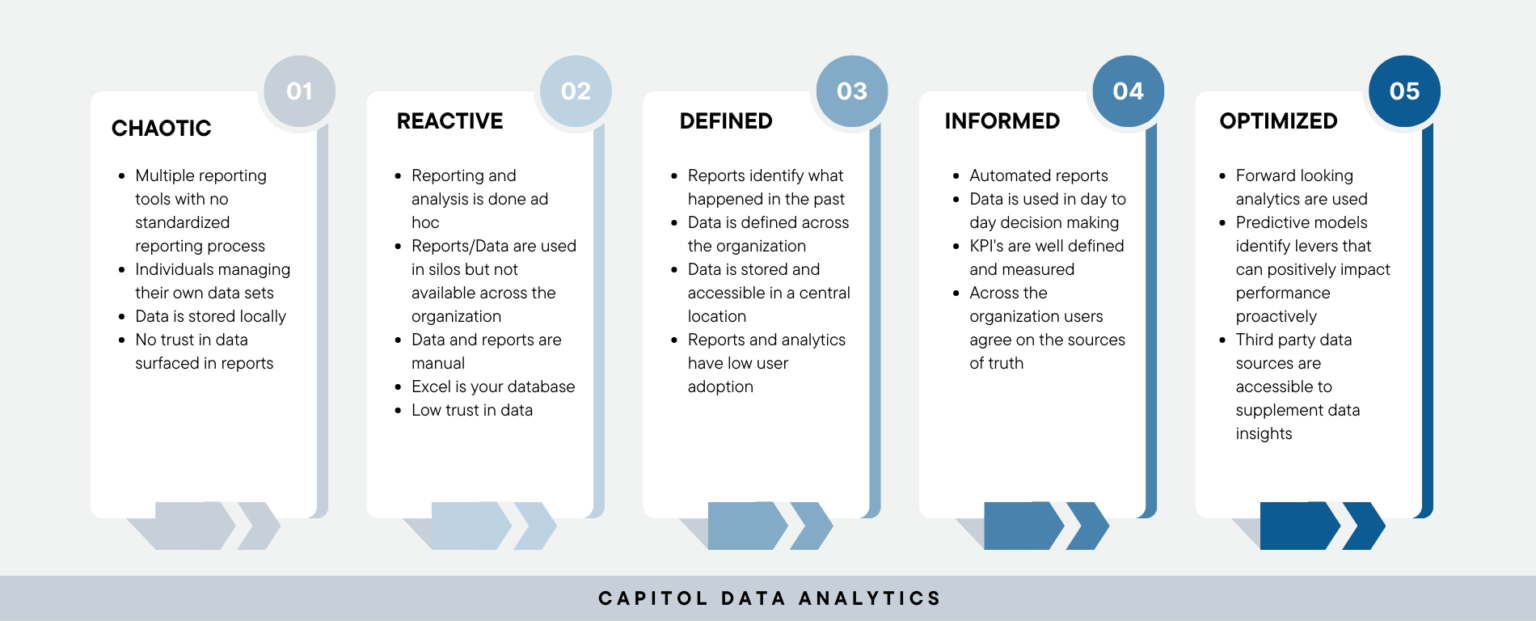
Data architecture
Data architecture covers technology infrastructure and data governance. Technology infrastructure focuses on the tools that allow data to be useful for the business. It is hard to figure out what tools are useful, with the existence of hundreds of tools that all promise to be the best thing ever built. The first thing to focus on is proven technology stacks that are known to be effective. After narrowing down to the stacks that fit your business goals you should use the following bullet points to evaluate the tool’s fit.
- Relevant: The stack you choose should present data in a meaningful way to support a specific decision. The infrastructure should protect the integrity of the data by removing manual manipulation and human errors. Bad data provides irrelevant insights.
- Accessible: Identify who the end users are and how they will access the data. Consider how you will make the data available to end users with varying levels of data literacy. The tool should be accessible across the organization.
- Timely: Data is worthless if it isn’t available when you need it. The tool(s) you choose should provide results when necessary. Consider how often you need the data. Is their benefit to being real-time or are decisions made daily.
- Price Point: Data stacks have different costs for not only usage but maintenance. It is important to understand these costs and if the price drives enough value to support their use.
Data governance covers data security and accessibility. Data security ensures you are following all applicable laws and regulations. These may include GDPR and HIPAA. Additionally, access controls should be put in place to allow the appropriate personnel to view/use data. This is often handled by the administrator of your technology stack. Data accessibility refers to the documentation that communicates to the business what data is available and how it should be used. A good first step here is a data dictionary. Data dictionaries describe available data points and how they were created. Data accessibility is key in increasing trust in data initiatives and leading to widespread adoption amongst business users.
data team
People are at the heart of strategy. After alignment, having the right people on your team makes all the difference. To implement your strategy, you should evaluate the current capabilities of your team vs what is necessary to deliver on your strategy. Below are some common data team job titles and what they are responsible for.
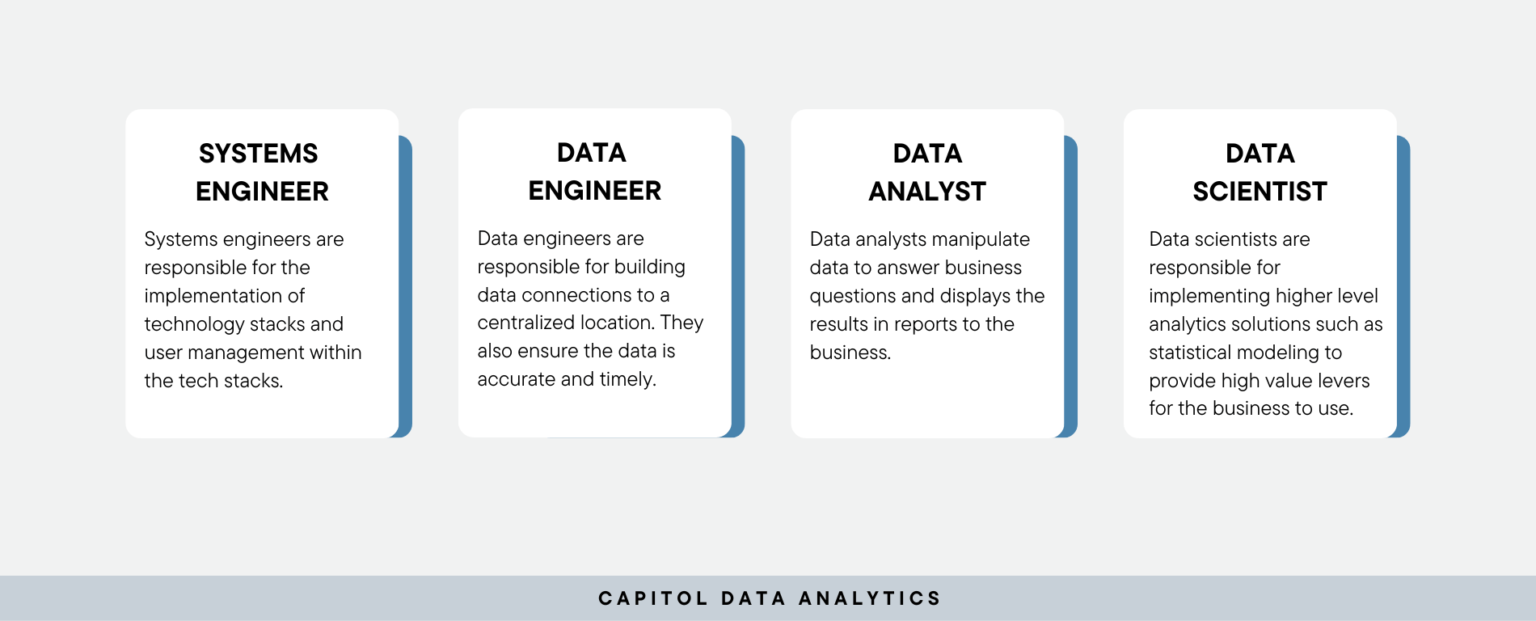
project roadmap
Prioritization boils down to delivering the right project at the right time. The “right” project is usually the project that can deliver the highest value with the least amount of effort. These quick wins should be first priority. Second, you should focus on high value projects that take more effort. The list of projects you created during the business alignment interviews be prioritized based on dependencies, value and effort. Once this is identified the projects should be scheduled in a roadmap. The project roadmap will take this list and turn it into a schedule to deliver projects in an order to maximize value and available development time.
Data Culture
80% of businesses cite cultural impediments as their greatest obstacle to becoming data driven. A data-driven culture increases user adoption and improves decision-making. The following steps will help you create a data driven culture:
- Communicate: The data roadmap should be widely available. Team members should be involved in building the strategy and continually informed to increase buy-in. The value of completed initiatives is shared with teammates. Routine feedback loops are implemented to provide feedback from the business to the data team to ensure alignment.
- Train: Develop data literacy programs to increase business user adoption of data initiatives and gain more value from their implementation. Provide training on new tools to make sure business end users are informed about their use. Create a process for onboarding new team members.
Related Articles We Think You Would Enjoy Next
A Data Analytics Approach to Optimal Warehouse Coverage
Data analytics helps warehouse operators be data driven. Find out how.
Read MoreBeyond Basic Books: How Tableau Dashboards Enhance QuickBooks Data
QBO reports leave a lot to be desired. How can Tableau fix this?
Read MoreCDA provides Both strategic planning and the team to implement A Data analytics roadmap. book a call to learn how we can help you.
